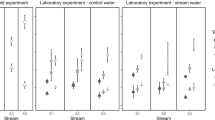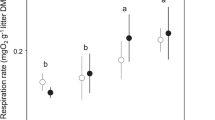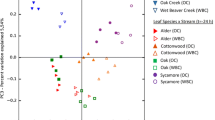Abstract
Ongoing climate change is expected to affect the diversity and activity of aquatic microbes, which play a key role in plant litter decomposition in forest streams. We used a before-after control-impact (BACI) design to study the effects of warming on a forest stream reach. The stream reach was divided by a longitudinal barrier, and during 1 year (ambient year) both stream halves were at ambient temperature, while in the second year (warmed year) the temperature in one stream half was increased by ca. 3 °C above ambient temperature (experimental half). Fine-mesh bags containing oak (Quercus robur L.) leaves were immersed in both stream halves for up to 60 days in spring and autumn of the ambient and warmed years. We assessed leaf-associated microbial diversity by denaturing gradient gel electrophoresis and identification of fungal conidial morphotypes and microbial activity by quantifying leaf mass loss and productivity of fungi and bacteria. In the ambient year, no differences were found in leaf decomposition rates and microbial productivities either between seasons or stream halves. In the warmed year, phosphorus concentration in the stream water, leaf decomposition rates, and productivity of bacteria were higher in spring than in autumn. They did not differ between stream halves, except for leaf decomposition, which was higher in the experimental half in spring. Fungal and bacterial communities differed between seasons in both years. Seasonal changes in stream water variables had a greater impact on the activity and diversity of microbial decomposers than a warming regime simulating a predicted global warming scenario.






Similar content being viewed by others
References
IPCC (2014) Summary for policymakers. In: Field CB, Barros VR, Dokken DJ, Mach KJ, Mastrandrea MD, Bilir TE, Chatterjee M, Ebi KL, Estrada YO, Genova RC, Girma B, Kissel ES, Levy AN, MacCracken S, Mastrandrea PR, White LL (eds) Climate change 2014: impacts, adaptation, and vulnerability. Part A: global and sectoral aspects. Contribution of working group II to the fifth assessment report of the Intergovernmental Panel on Climate Change. Cambridge University Press, Cambridge
Allan JD, Castillo MM (2007) Stream ecology: structure and function of running waters. Springer, Dordrecht
Stefan HG, Sinokrot BA (1993) Projected global climate change impact on water temperatures in five North Central U.S. streams. Clim Change 24:353–381
Suberkropp K (1998) Microorganisms and organic matter decomposition. In: Naiman R, Bilby RE (eds) River ecology and management: lessons from the pacific coastal ecoregion. Springer, New York, pp 120–143
Bärlocher F (2005) Freshwater fungal communities. Taylor and Francis, CRC Press, Boca Raton, Florida
Chamier A-C, Dixon PA (1982) Pectinases in leaf degradation by aquatic hyphomycetes: the enzymes and leaf maceration. J Gen Microbiol 128:2469–2483
Gessner MO, Gulis V, Kuehn KA, Chauvet E, Suberkropp K (2007) Fungal decomposers of plant litter in aquatic ecosystems. In: Kubicek CP, Druzhinina IS (eds) The mycota: environmental and microbial relationships, vol IV, 2nd edn. Springer, Berlin, pp 301–321
Gulis V, Suberkropp K (2003) Leaf litter decomposition and microbial activity in nutrient-enriched and unaltered reaches of a headwater stream. Freshw Biol 48:123–134
Pascoal C, Cássio F (2004) Contribution of fungi and bacteria to leaf litter decomposition in a polluted river. Appl Environ Microbiol 70:5266–5273
Bärlocher F, Kendrick B (1975) Leaf-conditioning by microorganisms. Oecologia 20:359–362
Graça MAS, Cressa C (2010) Leaf quality of some tropical and temperate tree species as food resource for stream shredders. Int Rev Hydrobiol 95:27–41
Chauvet E, Suberkropp K (1998) Temperature and sporulation of aquatic hyphomycetes. Appl Environ Microbiol 64:1522–1525
Duarte S, Fernandes I, Nogueira M-J, Cássio F, Pascoal C (2013) Temperature alters interspecific relationships among aquatic fungi. Fungal Ecol 6:187–191
Dang CK, Schindler M, Chauvet E, Gessner MO (2009) Temperature oscillation coupled with fungal community shifts can modulate warming effects on litter decomposition. Ecology 90:122–131
Fernandes I, Uzun B, Pascoal C, Cássio F (2009) Responses of aquatic fungal communities on leaf litter to temperature-change events. Int Rev Hydrobiol 94:410–418
Fernandes I, Pascoal C, Guimarães H, Pinto R, Sousa I, Cássio F (2012) Higher temperature reduces the effects of litter quality on decomposition by aquatic fungi. Freshw Biol 57:2306–2317
Ferreira V, Chauvet E (2011) Future increase in temperature more than decrease in litter quality can affect microbial litter decomposition in streams. Oecologia 167:279–291
Ferreira V, Chauvet E (2011) Synergistic effects of water temperature and dissolved nutrients on litter decomposition and associated fungi. Glob Change Biol 17:551–564
Batista D, Pascoal C, Cássio F (2012) Impacts of warming on aquatic decomposers along a gradient of cadmium stress. Environ Pollut 169:35–41
Geraldes P, Pascoal C, Cássio F (2012) Effects of increased temperature and aquatic fungal diversity loss on litter decomposition. Fungal Ecol 5:734–740
Gonçalves AL, Graça MAS, Canhoto C (2013) The effect of temperature on leaf decomposition and diversity of associated aquatic hyphomycetes depends on the substrate. Fungal Ecol 6:546–553
Drake JA, Huxel GR, Hewitt CL (1996) Microcosms as models for generating and testing community theory. Ecology 77:670–677
Fraser LH (1999) The use of microcosms as an experimental approach to understanding terrestrial ecosystem functioning. Adv Sp Res 24:297–302
Fabre E, Chauvet E (1998) Leaf breakdown along an altitudinal stream gradient. Arch Hydrobiol 141:167–179
Taylor BR, Chauvet E (2014) Relative influence of shredders and fungi on leaf litter decomposition along a river altitudinal gradient. Hydrobiologia 721:239–250
Irons JG, Oswood MW, Stout RJ, Pringle CM (1994) Latitudinal patterns in leaf litter breakdown: is temperature really important? Freshw Biol 32:401–411
Parmesan C, Yohe G (2003) A globally coherent fingerprint of climate change impacts across natural systems. Nature 421:37–42
Boyero L, Pearson RG, Gessner MO, Barmuta LA, Ferreira V, Graça MAS et al (2011) A global experiment suggests climate warming will not accelerate litter decomposition in streams but might reduce carbon sequestration. Ecol Lett 14:289–294
Friberg N, Christensen JB, Olafsson JS, Gislason GM, Larsen SE, Lauridsen TL (2009) Relationship between structure and function in streams contrasting in temperature: possible impacts of climate change on running water ecosystems. Freshw Biol 54:2051–2068
Chergui H, Pattee E (1990) The influence of season on the breakdown of submerged leaves. Arch Hydrobiol 120:1–12
Swan CM, Palmer MA (2004) Leaf diversity alters litter breakdown in a Piedmont stream. J N Am Benthol Soc 23:15–28
Woodward G, Dybkjaer JB, Ólafsson JS, Gíslason GM, Hannesdóttir ER, Friberg N (2010) Sentinel systems on the razor’s edge: effects of warming on Arctic geothermal stream ecosystems. Glob Change Biol 16:1979–1991
Hogg ID, Williams DD (1996) Response of stream invertebrates to a global-warming thermal regime: an ecosystem-level manipulation. Ecology 77:395–407
Bärlocher F, Seena S, Wilson KP, Williams DD (2008) Raised water temperature lowers diversity of hyporheic aquatic hyphomycetes. Freshw Biol 53:368–379
Canhoto C, de Lima J, Traça de Almeida A (2013) Warming up a stream reach: design of a hydraulic and heating system. Limnol Oceanogr Methods 11:410–417
Ferreira V, Canhoto C (2014) Effect of experimental and seasonal warming on litter decomposition in a temperate stream. Aquat Sci 76:155–163
Ferreira V, Canhoto C (2015) Future increase in temperature may stimulate litter decomposition in temperate mountain streams: evidence from a stream manipulation experiment. Freshw Biol 60:881–892
Ylla I, Canhoto C, Romaní AM (2014) Effects of warming on stream biofilm organic matter use capabilities. Microbiol Ecol 68:132–145
Miranda P, Coelho FES, Tomé AR, Valente MA (2002) 20th century Portuguese climate and climate scenarios. In: Santos FD, Forbes K, Moita R (eds) Climate change in Portugal. Scenarios, impacts and adaptation measures. SIAM project, Gradiva Publications, Lda, Lisbon, pp 23–83
Ferreira V, Encalada AC, Graça MAS (2012) Effects of litter diversity on decomposition and biological colonization of submerged litter in temperate and tropical streams. Freshw Sci 31:945–962
Pozo J, González E, Díez JR, Molinero J, Elósegui A (1997) Inputs of particulate organic matter to streams with different riparian vegetation. J North Am Benthol Soc 16:602–611
González E, Pozo J (1996) Longitudinal and temporal patterns of benthic coarse particulate organic matter in the Agüera stream (northern Spain). Aquat Sci 58:355–366
Morrill JC, Bales RC, Conklin MH (2005) Estimating stream temperature from air temperature: implications for future water quality. J Environ Eng 131:131–139
Gore JA (1996) Discharge measurements and stream flow analysis. In: Hauer FR, Lamberti GA (eds) Methods in stream ecology. Academic press, New York, pp 53–74
APHA (1995) Standard methods for the examination of water and watershed. American Public Health Association, Washington DC
White TJ, Bruns T, Lee S, Taylor JW (1990) Amplification and direct sequencing of fungal ribosomal RNA genes for phylogenetics. In: Innis MA, Gelfand DH, Sninsky JJ, White TJ (eds) PCR protocols: a guide to methods and applications. Academic Press Inc, New York, pp 315–322
Muyzer G, de Waal EC, Uitterlinden AG (1993) Profiling of complex microbial populations by denaturing gradient gel electrophoresis analysis of polymerase chain reaction-amplified genes coding for 16S rRNA. Appl Environ Microbiol 59:695–700
Bärlocher F (2005) Sporulation by aquatic hyphomycetes. In: Graça MAS, Bärlocher F, Gessner MO (eds) Methods to study litter decomposition: a practical guide. Springer, Dordrecht, pp 185–188
Gulis V, Marvanová L, Descals E (2005) An illustrated key to the common temperate species of aquatic hyphomycetes. In: Graça MAS, Bärlocher F, Gessner MO (eds) Methods to study litter decomposition: a practical guide. Springer, Dordrecht, pp 153–168
Suberkropp K, Weyers H (1996) Application of fungal and bacterial production methodologies to decomposing leaves in streams. Appl Environ Microbiol 62:1610–1615
Gessner MO, Newell SY (2002) Biomass, growth rate, and production of filamentous fungi in plant litter. In: Hurst CJ, Crawford RL, Knudsen C, McIerney M, Stetzenbach LD (eds) Manual of environmental microbiology, 2nd edn. ASM Press, Washington DC, pp 390–408
Kirchman DL (1993) Leucine incorporation as a measure of biomass production by heterotrophic bacteria. In: Kemp PF, Sherr BF, Sherr EB, Cole JJ (eds) Handbook of methods in aquatic microbial ecology. Lewis Publishers, Boca Raton, pp 509–512
Zar JH (2010) Biostatistical analysis. Pearson Prentice-Hall, Upper Saddle River
Kruskal JB, Wish M (1978) Multidimensional scaling. Sage Publications, Beverley Hills
Anderson MJ (2001) A new method for non-parametric multivariate analysis of variance. Aust Ecol 26:32–46
Fernandes I, Seena S, Pascoal C, Cássio F (2014) Elevated temperature may intensify the positive effects of nutrients on microbial decomposition in streams. Freshw Biol 59:2390–2399
Nikolcheva LG, Bärlocher F (2005) Seasonal and substrate preferences of fungi colonizing leaves in streams: traditional versus molecular evidence. Environ Microbiol 7:270–280
Duarte S, Pascoal C, Alves A, Correia A, Cássio F (2010) Assessing the dynamic of microbial communities during leaf decomposition in a low-order stream by microscopic and molecular techniques. Microbiol Res 165:351–362
Das M, Royer TV, Leff LG (2007) Diversity of fungi, bacteria, and actinomycetes on leaves decomposing in a stream. Appl Environ Microbiol 73:756–767
Duarte S, Pascoal C, Garabétian F, Cássio F, Charcosset J-Y (2009) Microbial decomposer communities are mainly structured by trophic status in circumneutral and alkaline streams. Appl Environ Microbiol 75:6211–6221
Muyzer G, Brinkoff T, Nübel U, Santegoeds C, Schäfer H, Wawer C (2004) Denaturing gradient gel electrophoresis (DGGE) in microbial ecology. In: Kowalchuk GA, de Bruijn FJ, Head IM, Akkermans ADL, van Elsas JD (eds) Molecular microbial ecology manual. Kluwer Academic Publishers, The Netherlands, pp 743–770
Suberkropp K (1984) The effect of temperature on the seasonal occurrence of aquatic hyphomycetes. Trans Br Mycol Soc 82:53–62
Bärlocher F (2000) Water-borne conidia of aquatic hyphomycetes: seasonal and yearly patterns in Catamaran Brook, New Brunswick, Canada. Can J Bot 78:157–167
Ferreira V, Chauvet E, Canhoto C (2015) Effects of experimental warming, litter species, and presence of macroinvertebrates on litter decomposition and associated decomposers in a temperate mountain stream. Can J Fish Aquat Sci 72:206–216
Brown JH, Gillooly JF, Allen AP, Savage VM, West GB (2004) Towards a metabolic theory of ecology. Ecology 85:1771–1789
Mas-Martí E, Muñoz I, Oliva F, Canhoto C (2015) Effects of increased water temperature on leaf litter quality and detritivore performance: a whole-reach manipulative experiment. Freshw Biol 60:184–197
Lecerf A, Dobson M, Dang CK, Chauvet E (2005) Riparian plant species loss alters trophic dynamics in detritus-based stream ecosystems. Oecologia 146:432–442
Adams HE, Crump BC, Kling GW (2010) Temperature controls on aquatic bacterial production and community dynamics in arctic lakes and streams. Environ Microbiol 12:1319–1333
Flury S, Gessner MO (2011) Experimentally simulated global warming and nitrogen enrichment effects on microbial litter decomposers in a marsh. Appl Environ Microbiol 77:803–809
Finlay BJ, Maberly SC, Cooper JI (1997) Microbial diversity and ecosystem function. Oikos 80:209–213
Verma B, Robarts RD, Headley JV (2003) Seasonal changes in fungal production and biomass on standing dead Scirpus lacustris litter in a Northern prairie wetland. Appl Environ Microbiol 69:1043–1050
Buesing N, Gessner MO (2006) Benthic bacterial and fungal productivity and carbon turnover in a freshwater marsh. Appl Environ Microbiol 72:596–605
Acuña V, Wolf A, Uehlinger U, Tockner K (2008) Temperature dependence of stream benthic respiration in an Alpine river network under global warming. Freshw Biol 53:2076–2088
Young RG, Matthaei CD, Townsend CR (2008) Organic matter breakdown and ecosystem metabolism: functional indicators for assessing river ecosystem health. J N Am Benthol Soc 27:605–625
Gulis V, Ferreira V, Graça MAS (2006) Stimulation of leaf litter decomposition and associated fungi and invertebrates by moderate eutrophication: implications for stream assessment. Freshw Biol 51:1655–1669
Woodward G, Gessner MO, Giller PS, Gulis V, Hladyz S, Lecerf A et al (2012) Continental-scale effects of nutrient pollution on stream ecosystem functioning. Science 336:1438–1440
Park S, Cho KH (2003) Nutrient leaching from leaf litter of emergent macrophyte (Zizania latifolia) and the effects of water temperature on the leaching process. Korean J Biol Sci 7:289–294
Baldrian P, Šnajdr J, Merhautová V, Dobiášová P, Cajthaml T, Valášková V (2012) Responses of the extracellular enzyme activities in hardwood forest to soil temperature and seasonality and the potential effects of climate change. Soil Biol Biochem 56:60–68
Murdoch PS, Baron JS, Miller TL (2000) Potential effects of climate change on surface-water quality in North America. J Am Water Res Assoc 36:347–366
Martínez A, Larrañaga A, Pérez J, Descals E, Pozo J (2014) Temperature affects leaf litter decomposition in low-order forest streams: field and microcosm approaches. FEMS Microbiol Ecol 87:257–267
Durant JM, Hjermann DØ, Ottersen G, Stenseth NC (2007) Climate and the match or mismatch between predator requirements and resource availability. Clim Res 33:271–283
Lecerf A, Richardson J (2010) Litter decomposition can detect effects of high and moderate levels of forest disturbance on stream condition. Forest Ecol Manag 259:2433–2443
Acknowledgments
We thank Ana Lírio and João Rosa for valuable help in the field, Amado & Amado Company for the efficacy and constant maintenance of the warming system, and the Lousã Town Hall for its collaboration and logistic support. We also want to thank two anonymous reviewers and Felix Bärlocher for the comments and suggestions made on an earlier version of the manuscript. This study was funded by IMAR-CMA, CBMA-UM, the European Fund for Economic and Regional Development (FEDER) through the Program Operational Factors of Competitiveness (COMPETE), and National Funds through the Portuguese Science and Technology Foundation (FCT) under the projects “Predicting the effect of global warming on stream ecosystems” (PTDC/CLI/67180/2006; FCOMP-01-0124-FEDER-007112) and “Development of molecular tools for assessing fungal diversity and activity in freshwaters” (PTDC/AAC-AMB/113746/2009; FCOMP-01-0124-FEDER-013954) and PEst-C/BIA/UI4050/2011. Financial support granted by the FCT to VF (SFRH/BPD/34368/2006 and SFRH/BPD/76482/2011, program POPH/FSE; IF/00129/2014) and SD (SFRH/BPD/47574/2008 and SFRH/BPD/109842/2015) is also gratefully acknowledged.
Author information
Authors and Affiliations
Corresponding author
Electronic supplementary material
Below is the link to the electronic supplementary material.
Table S1
(DOCX 27 kb)
Rights and permissions
About this article
Cite this article
Duarte, S., Cássio, F., Ferreira, V. et al. Seasonal Variability May Affect Microbial Decomposers and Leaf Decomposition More Than Warming in Streams. Microb Ecol 72, 263–276 (2016). https://doi.org/10.1007/s00248-016-0780-2
Received:
Accepted:
Published:
Issue Date:
DOI: https://doi.org/10.1007/s00248-016-0780-2




